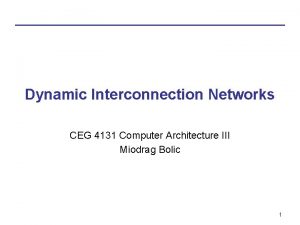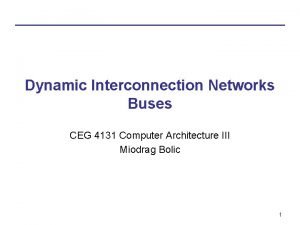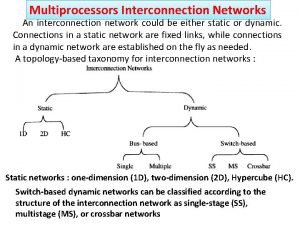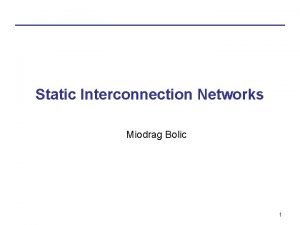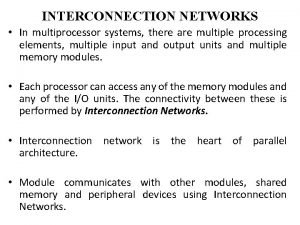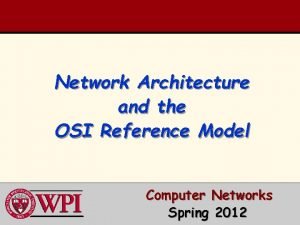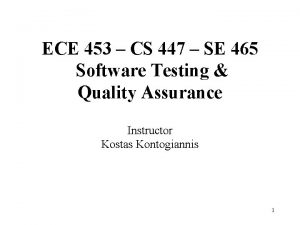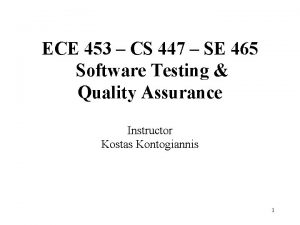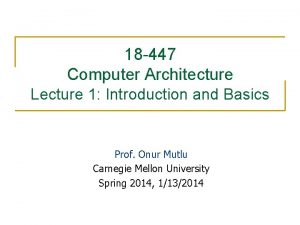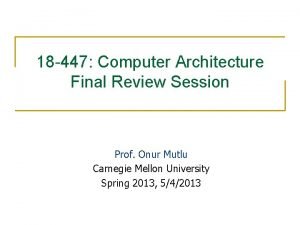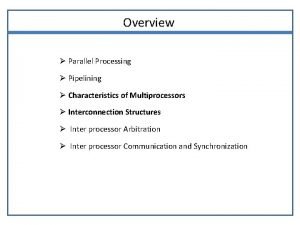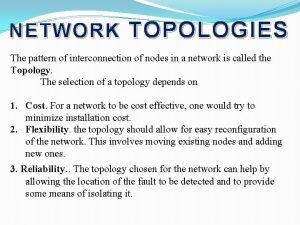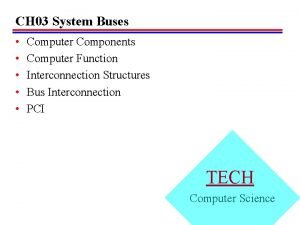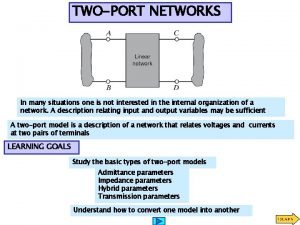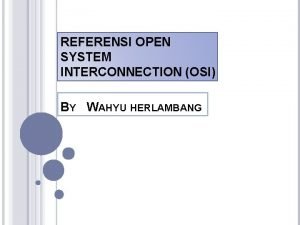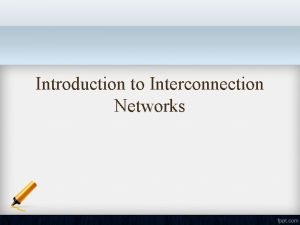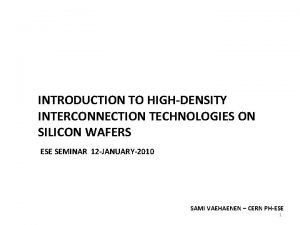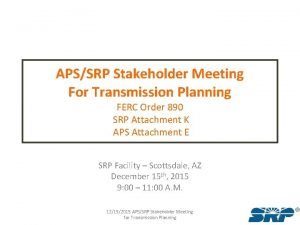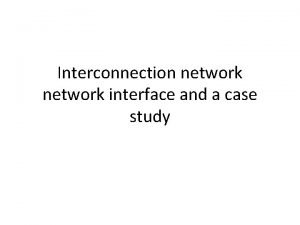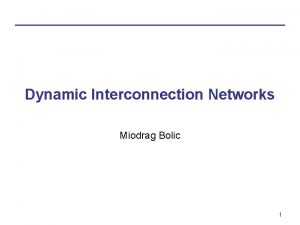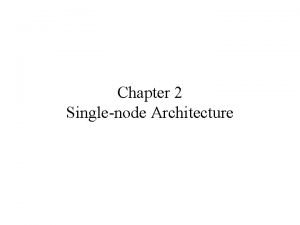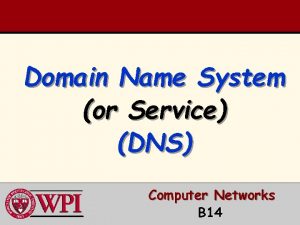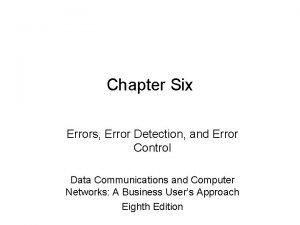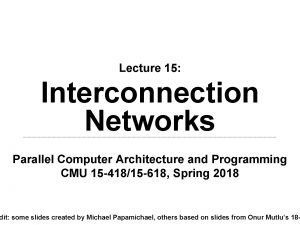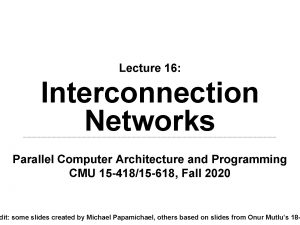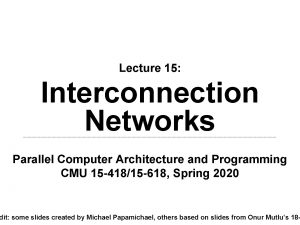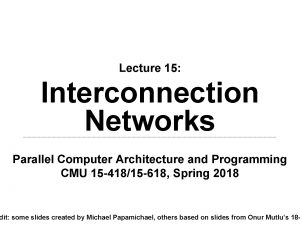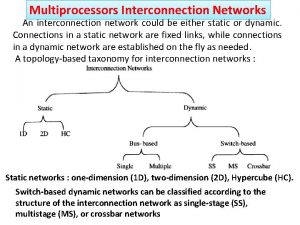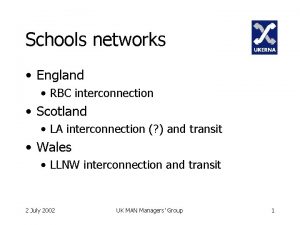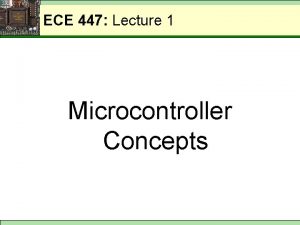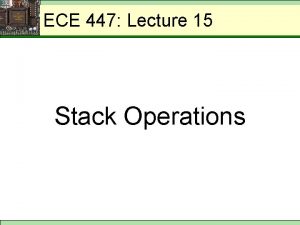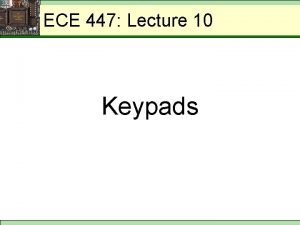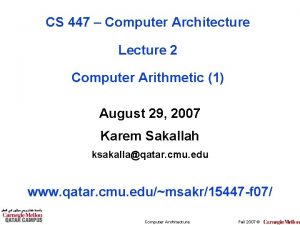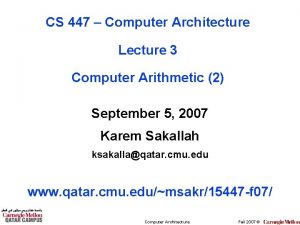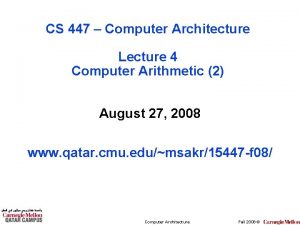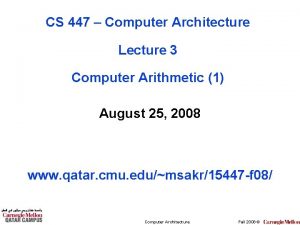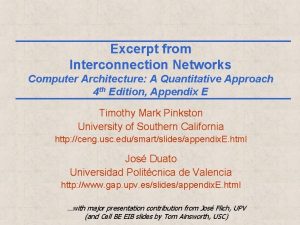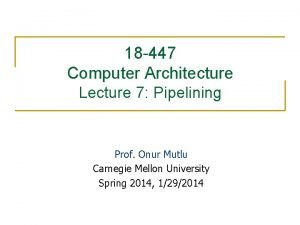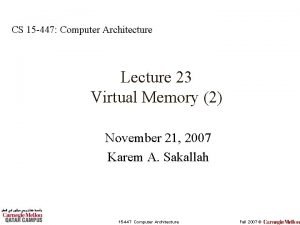18 447 Computer Architecture Lecture 30 Interconnection Networks











































































- Slides: 75

18 -447 Computer Architecture Lecture 30: Interconnection Networks Prof. Onur Mutlu Carnegie Mellon University Spring 2014, 4/28/2014

Lab 7: Multi-Core Cache Coherence n Last submission accepted on May 9, 11: 59 pm Cycle-level modeling of the MESI cache coherence protocol n Since this is the last lab n q q An automatic extension of 7 days granted for everyone No other late days accepted 2

Midterm 2 Grade Distribution Number of Students 12 10 8 6 4 2 0 0 10 20 30 40 50 60 70 80 90 100 3

Midterm 2 Statistics n n n MAX MIN MEDIAN MEAN STD 90. 71 22. 86 48. 01 42. 5 16. 24 4

Final Exam: May 6 n May 6, 8: 30 -11: 30 am, Hamerschlag Hall B 103 n Comprehensive (over all topics in course) n Three cheat sheets allowed n We might have a review session n Remember this is 25% of your grade q q q I will take into account your improvement over the course Know all concepts, especially the previous midterm concepts Same advice as before for Midterms I and II 5

A Note on 742, Research, Jobs n I am teaching Parallel Computer Architecture next semester (Fall 2014) q q n n Deep dive into many topics we covered And, many topics we did not cover Research oriented with an open-ended research project Cutting edge research and topics in HW/SW interface If you are enjoying 447 and are doing well, you can take it no need to have taken 640/740 talk with me If you are excited about Computer Architecture research or looking for a job/internship in this area talk with me 6

Last Two Lectures n Multiprocessors n Bottlenecks in parallel processing n Multiprocessor correctness q q n Sequential consistency Weaker consistency Cache coherence q q Software vs. hardware Update vs. invalidate Snoopy cache vs. directory based VI MSI MESI MOESI … 7

Today n Wrap up cache coherence n Interconnection networks 8

Readings: Multiprocessing n Required q q n Amdahl, “Validity of the single processor approach to achieving large scale computing capabilities, ” AFIPS 1967. Lamport, “How to Make a Multiprocessor Computer That Correctly Executes Multiprocess Programs, ” IEEE Transactions on Computers, 1979 Recommended q q q Mike Flynn, “Very High-Speed Computing Systems, ” Proc. of IEEE, 1966 Hill, Jouppi, Sohi, “Multiprocessors and Multicomputers, ” pp. 551 -560 in Readings in Computer Architecture. Hill, Jouppi, Sohi, “Dataflow and Multithreading, ” pp. 309 -314 in Readings in Computer Architecture. 9

Readings: Memory Consistency n Required q n Lamport, “How to Make a Multiprocessor Computer That Correctly Executes Multiprocess Programs, ” IEEE Transactions on Computers, 1979 Recommended q q q Gharachorloo et al. , “Memory Consistency and Event Ordering in Scalable Shared-Memory Multiprocessors, ” ISCA 1990. Charachorloo et al. , “Two Techniques to Enhance the Performance of Memory Consistency Models, ” ICPP 1991. Ceze et al. , “Bulk. SC: bulk enforcement of sequential consistency, ” ISCA 2007. 10

Readings: Cache Coherence n Required q q q n Culler and Singh, Parallel Computer Architecture n Chapter 5. 1 (pp 269 – 283), Chapter 5. 3 (pp 291 – 305) P&H, Computer Organization and Design n Chapter 5. 8 (pp 534 – 538 in 4 th and 4 th revised eds. ) Papamarcos and Patel, “A low-overhead coherence solution for multiprocessors with private cache memories, ” ISCA 1984. Recommended q q q Censier and Feautrier, “A new solution to coherence problems in multicache systems, ” IEEE Trans. Computers, 1978. Goodman, “Using cache memory to reduce processor-memory traffic, ” ISCA 1983. Laudon and Lenoski, “The SGI Origin: a cc. NUMA highly scalable server, ” ISCA 1997. Martin et al, “Token coherence: decoupling performance and correctness, ” ISCA 2003. Baer and Wang, “On the inclusion properties for multi-level cache hierarchies, ” ISCA 1988. 11

Cache Coherence 12

Review: MESI State Machine from Lab 7 13

Review: Intel Pentium Pro Slide credit: Yale Patt 14

n Snoopy Cache vs. Directory Snoopy Cache Coherence + Miss latency (critical path) is short: request bus transaction to mem. + Global serialization is easy: bus provides this already (arbitration) + Simple: can adapt bus-based uniprocessors easily - Relies on broadcast messages to be seen by all caches (in same order): single point of serialization (bus): not scalable need a virtual bus (or a totally-ordered interconnect) n Directory - Adds indirection to miss latency (critical path): request dir. mem. - Requires extra storage space to track sharer sets n Can be approximate (false positives are OK) - Protocols and race conditions are more complex (for high-performance) + Does not require broadcast to all caches + Exactly as scalable as interconnect and directory storage (much more scalable than bus) 15

Revisiting Directory-Based Cache Coherence 16

Remember: Directory Based Coherence n Idea: A logically-central directory keeps track of where the copies of each cache block reside. Caches consult this directory to ensure coherence. n An example mechanism: q For each cache block in memory, store P+1 bits in directory n n q q q One bit for each cache, indicating whether the block is in cache Exclusive bit: indicates that the cache that has the only copy of the block and can update it without notifying others On a read: set the cache’s bit and arrange the supply of data On a write: invalidate all caches that have the block and reset their bits Have an “exclusive bit” associated with each block in each cache 17

Remember: Directory Based Coherence Example 18

Directory-Based Protocols n n Required when scaling past the capacity of a single bus Distributed, but: q q n n Coherence still requires single point of serialization (for write serialization) Serialization location can be different for every block (striped across nodes) We can reason about the protocol for a single block: one server (directory node), many clients (private caches) Directory receives Read and Read. Ex requests, and sends Invl requests: invalidation is explicit (as opposed to snoopy buses) 19

Directory: Basic Operations n Follow semantics of snoop-based system q n Directory: q q n but with explicit request, reply messages Receives Read, Read. Ex, Upgrade requests from nodes Sends Inval/Downgrade messages to sharers if needed Forwards request to memory if needed Replies to requestor and updates sharing state Protocol design is flexible q q Exact forwarding paths depend on implementation For example, do cache-to-cache transfer? 20

MESI Directory Transaction: Read P 0 acquires an address for reading: 1. Read P 0 Home 2. Dat. Ex (Dat. Shr) P 1 Culler/Singh Fig. 8. 16 21

Rd. Ex with Former Owner 1. Rd. Ex P 0 Home 2. Invl 3 a. Rev Owner 3 b. Dat. Ex 22

Contention Resolution (for Write) P 0 1 a. Rd. Ex 1 b. Rd. Ex 4. Invl 3. Rd. Ex 5 a. Rev Home 2 a. Dat. Ex P 1 2 b. NACK 5 b. Dat. Ex 23

Issues with Contention Resolution n Need to escape race conditions by: q NACKing requests to busy (pending invalidate) entries n q q n OR, queuing requests and granting in sequence Or some combination thereof Fairness q q n Original requestor retries Which requestor should be preferred in a conflict? Both interconnect delivery order and distance matter Preventing ping-ponging is important q Can be achieved with better synchronization mechanisms or better prediction mechanisms 24

Scaling the Directory: Some Questions n How large is the directory? n How can we reduce the access latency to the directory? n How can we scale the system to thousands of nodes? n Can we get the best of snooping and directory protocols? q Think heterogeneity 25

Directory: Data Structures 0 x 00 0 x 04 0 x 08 0 x 0 C … n n Required to support invalidation and cache block requests Key operation to support is set inclusion test q False positives are OK: want to know which caches may contain q n n Shared: {P 0, P 1, P 2} --Exclusive: P 2 ----- a copy of a block, and spurious invalidations are ignored False positive rate determines performance Most accurate (and expensive): full bit-vector Compressed representation, linked list, Bloom filters are all possible 26

Interconnection Network Basics 27

Where Is Interconnect Used? n To connect components n Many examples q q q Processors and processors Processors and memories (banks) Processors and caches (banks) Caches and caches I/O devices Interconnection network 28

Why Is It Important? n Affects the scalability of the system q q n How large of a system can you build? How easily can you add more processors? Affects performance and energy efficiency q q q How fast can processors, caches, and memory communicate? How long are the latencies to memory? How much energy is spent on communication? 29

Interconnection Network Basics n Topology q q n Routing (algorithm) q q n Specifies the way switches are wired Affects routing, reliability, throughput, latency, building ease How does a message get from source to destination Static or adaptive Buffering and Flow Control q What do we store within the network? n q q Entire packets, parts of packets, etc? How do we throttle during oversubscription? Tightly coupled with routing strategy 30

Topology n n n Bus (simplest) Point-to-point connections (ideal and most costly) Crossbar (less costly) Ring Tree Omega Hypercube Mesh Torus Butterfly … 31

Metrics to Evaluate Interconnect Topology n Cost n Latency (in hops, in nanoseconds) Contention n Many others exist you should think about n q q q Energy Bandwidth Overall system performance 32

Bus + Simple + Cost effective for a small number of nodes + Easy to implement coherence (snooping and serialization) - Not scalable to large number of nodes (limited bandwidth, electrical loading reduced frequency) - High contention fast saturation 0 1 2 3 4 5 6 7 33

Point-to-Point Every node connected to every other + Lowest contention + Potentially lowest latency + Ideal, if cost is not an issue 0 7 1 6 -- Highest cost O(N) connections/ports per node O(N 2) links -- Not scalable -- How to lay out on chip? 2 5 3 4 34

Crossbar n n n Every node connected to every other (non-blocking) except one can be using the connection at any given time Enables concurrent transfers to non-conflicting destinations Could be cost-effective for small number of nodes 7 + Low latency and high throughput - Expensive - Not scalable O(N 2) cost - Difficult to arbitrate as N increases 6 5 4 3 2 Used in core-to-cache-bank networks in - IBM POWER 5 - Sun Niagara I/II 1 0 0 1 2 3 4 5 6 7 35

Another Crossbar Design 0 1 2 3 4 5 6 7 36

Sun Ultra. SPARC T 2 Core-to-Cache Crossbar n High bandwidth interface between 8 cores and 8 L 2 banks & NCU n n 4 -stage pipeline: req, arbitration, selection, transmission 2 -deep queue for each src/dest pair to hold data transfer request 37

Bufferless and Buffered Crossbars 0 NI 1 NI 2 NI 3 NI + Simpler arbitration/ scheduling Flow Control + Efficient support for variable-size packets Flow Control Bufferless Buffered Crossbar Output Arbiter - Requires N 2 buffers 38

Can We Get Lower Cost than A Crossbar? n Yet still have low contention compared to a bus? n Idea: Multistage networks 39

Multistage Logarithmic Networks n n Idea: Indirect networks with multiple layers of switches between terminals/nodes Cost: O(Nlog. N), Latency: O(log. N) Many variations (Omega, Butterfly, Benes, Banyan, …) Omega Network: conflict 40

Multistage Networks (Circuit Switched) 0 0 1 1 2 2 3 3 4 4 5 5 6 6 7 7 2 -by-2 crossbar n n Multistage has more restrictions on feasible concurrent Tx-Rx pairs But more scalable than crossbar in cost, e. g. , O(N log. N) for Butterfly 41

Multistage Networks (Packet Switched) 0 n 0 1 1 2 2 3 3 4 4 5 5 6 6 7 7 2 -by-2 router Packets “hop” from router to router, pending availability of the next-required switch and buffer 42

Aside: Circuit vs. Packet Switching n Circuit switching sets up full path Establish route then send data q Noone else can use those links + faster arbitration -- setting up and bringing down links takes time q n Packet switching routes per packet Route each packet individually (possibly via different paths) q If link is free, any packet can use it -- potentially slower --- must dynamically switch + no setup, bring down time + more flexible, does not underutilize links q 43

Switching vs. Topology n n n Circuit/packet switching choice independent of topology It is a higher-level protocol on how a message gets sent to a destination However, some topologies are more amenable to circuit vs. packet switching 44

Another Example: Delta Network n n Single path from source to destination Each stage has different routers Proposed to replace costly crossbars as processor-memory interconnect Janak H. Patel , “Processor. Memory Interconnections for Multiprocessors, ” ISCA 1979. 8 x 8 Delta network 45

Another Example: Omega Network n n Single path from source to destination All stages are the same Used in NYU Ultracomputer Gottlieb et al. “The NYU Ultracomputer - Designing an MIMD Shared Memory Parallel Computer, ” IEEE Trans. On Comp. , 1983. 46

Ring + Cheap: O(N) cost - High latency: O(N) - Not easy to scale - Bisection bandwidth remains constant Used in Intel Haswell, Intel Larrabee, IBM Cell, many commercial systems today 47

Unidirectional Ring R R N-2 N-1 2 x 2 router 0 1 2 n Simple topology and implementation q q q Reasonable performance if N and performance needs (bandwidth & latency) still moderately low O(N) cost N/2 average hops; latency depends on utilization 48

Bidirectional Rings + Reduces latency + Improves scalability - Slightly more complex injection policy (need to select which ring to inject a packet into) 49

Hierarchical Rings + More scalable + Lower latency - More complex 50

More on Hierarchical Rings n n Hi. RD: A Low-Complexity, Energy-Efficient Hierarchical Ring Interconnect. SAFARI Technical Report No. 2012 -004. December 13, 2012. Discusses the design and implementation of a mostlybufferless hierarchical ring 51

Mesh n n n O(N) cost Average latency: O(sqrt(N)) Easy to layout on-chip: regular and equal-length links Path diversity: many ways to get from one node to another Used in Tilera 100 -core And many on-chip network prototypes 52

Torus Mesh is not symmetric on edges: performance very sensitive to placement of task on edge vs. middle n Torus avoids this problem + Higher path diversity (and bisection bandwidth) than mesh - Higher cost - Harder to lay out on-chip - Unequal link lengths n 53

Torus, continued n Weave nodes to make inter-node latencies ~constant 54

Trees Planar, hierarchical topology Latency: O(log. N) Good for local traffic + Cheap: O(N) cost + Easy to Layout - Root can become a bottleneck Fat trees avoid this problem (CM-5) Fat Tree 55

CM-5 Fat Tree n n n Fat tree based on 4 x 2 switches Randomized routing on the way up Combining, multicast, reduction operators supported in hardware q Thinking Machines Corp. , “The Connection Machine CM-5 Technical Summary, ” Jan. 1992. 56

Hypercube Latency: O(log. N) n Radix: O(log. N) n #links: O(Nlog. N) + Low latency - Hard to lay out in 2 D/3 D n 11 01 00 01 01 11 10 11 01 00 10 01 01 10 10 00 00 11 11 10 10 00 10 57

Caltech Cosmic Cube n n 64 -node message passing machine Seitz, “The Cosmic Cube, ” CACM 1985. 58

Handling Contention n n Two packets trying to use the same link at the same time What do you do? q q q n Buffer one Drop one Misroute one (deflection) Tradeoffs? 59

Bufferless Deflection Routing n Key idea: Packets are never buffered in the network. When two packets contend for the same link, one is deflected. 1 New traffic can be injected whenever there is a free output link. Destination 1 Baran, “On Distributed Communication Networks. ” RAND Tech. Report. , 1962 / IEEE Trans. Comm. , 1964. 60

Bufferless Deflection Routing n Input buffers are eliminated: packets are buffered in pipeline latches and on network links Input Buffers North South East West Local Deflection Routing Logic 61

Routing Algorithm n Types q q q n Deterministic: always chooses the same path for a communicating source-destination pair Oblivious: chooses different paths, without considering network state Adaptive: can choose different paths, adapting to the state of the network How to adapt q q Local/global feedback Minimal or non-minimal paths 62

Deterministic Routing n n All packets between the same (source, dest) pair take the same path Dimension-order routing q q E. g. , XY routing (used in Cray T 3 D, and many on-chip networks) First traverse dimension X, then traverse dimension Y + Simple + Deadlock freedom (no cycles in resource allocation) - Could lead to high contention - Does not exploit path diversity 63

Deadlock n n n No forward progress Caused by circular dependencies on resources Each packet waits for a buffer occupied by another packet downstream 64

Handling Deadlock n Avoid cycles in routing q Dimension order routing n q Cannot build a circular dependency Restrict the “turns” each packet can take n Avoid deadlock by adding more buffering (escape paths) n Detect and break deadlock q Preemption of buffers 65

Turn Model to Avoid Deadlock n Idea q q q n Analyze directions in which packets can turn in the network Determine the cycles that such turns can form Prohibit just enough turns to break possible cycles Glass and Ni, “The Turn Model for Adaptive Routing, ” ISCA 1992. 66

Oblivious Routing: Valiant’s Algorithm n An example of oblivious algorithm n n Goal: Balance network load Idea: Randomly choose an intermediate destination, route to it first, then route from there to destination q Between source-intermediate and intermediate-dest, can use dimension order routing + Randomizes/balances network load - Non minimal (packet latency can increase) n Optimizations: q q Do this on high load Restrict the intermediate node to be close (in the same quadrant) 67

Adaptive Routing n Minimal adaptive Router uses network state (e. g. , downstream buffer occupancy) to pick which “productive” output port to send a packet to q Productive output port: port that gets the packet closer to its destination + Aware of local congestion - Minimality restricts achievable link utilization (load balance) q n Non-minimal (fully) adaptive “Misroute” packets to non-productive output ports based on network state + Can achieve better network utilization and load balance - Need to guarantee livelock freedom q 68

On-Chip Networks PE PE R PE R R • Connect cores, caches, memory controllers, etc R PE R R Router – Buses and crossbars are not scalable • Packet switched • 2 D mesh: Most commonly used topology • Primarily serve cache misses and memory requests Processing Element (Cores, L 2 Banks, Memory Controllers, etc) 69

On-chip Networks P E P E R R R R P E P E R Input Port with Buffers VC Identifier R R R From East From West VC 0 VC 1 VC 2 Control Logic Routing Unit (RC) VC Allocator (VA) Switch Allocator (SA) To East From North To West To North To South To PE From South R Router P E Processing Element Crossbar (5 x 5) From PE Crossbar (Cores, L 2 Banks, Memory Controllers etc) 70

On-Chip vs. Off-Chip Interconnects n On-chip advantages q q q n Low latency between cores No pin constraints Rich wiring resources Very high bandwidth Simpler coordination On-chip constraints/disadvantages q q 2 D substrate limits implementable topologies Energy/power consumption a key concern Complex algorithms undesirable Logic area constrains use of wiring resources 71

On-Chip vs. Off-Chip Interconnects (II) n Cost q q q n Off-chip: Channels, pins, connectors, cables On-chip: Cost is storage and switches (wires are plentiful) Leads to networks with many wide channels, few buffers Channel characteristics q q On chip short distance low latency On chip RC lines need repeaters every 1 -2 mm n n Can put logic in repeaters Workloads q Multi-core cache traffic vs. supercomputer interconnect traffic 72

Motivation for Efficient Interconnect n In many-core chips, on-chip interconnect (No. C) consumes significant power Intel Terascale: ~28% of chip power Intel SCC: ~10% MIT RAW: ~36% Core L 2 Slice n L 1 Router Recent work 1 uses bufferless deflection routing to reduce power and die area 1 Moscibroda and Mutlu, “A Case for Bufferless Deflection Routing in On-Chip Networks. ” ISCA 2009. 73

Research Topics in Interconnects n n n Plenty of topics in interconnection networks. Examples: Energy/power efficient and proportional design Reducing Complexity: Simplified router and protocol designs Adaptivity: Ability to adapt to different access patterns Qo. S and performance isolation q n Co-design of No. Cs with other shared resources q n n Reducing and controlling interference, admission control End-to-end performance, Qo. S, power/energy optimization Scalable topologies to many cores, heterogeneous systems Fault tolerance Request prioritization, priority inversion, coherence, … New technologies (optical, 3 D) 74

One Example: Packet Scheduling n Which packet to choose for a given output port? q q n Common strategies q q q n Router needs to prioritize between competing flits Which input port? Which virtual channel? Which application’s packet? Round robin across virtual channels Oldest packet first (or an approximation) Prioritize some virtual channels over others Better policies in a multi-core environment q q Use application characteristics Minimize energy 75
 Chordal ring
Chordal ring Example of interrupt in os
Example of interrupt in os Baseline network in computer architecture
Baseline network in computer architecture Computer buses
Computer buses Dynamic interconnection network are
Dynamic interconnection network are Static interconnection networks
Static interconnection networks Direct interconnection networks
Direct interconnection networks Interconnection networks in multiprocessor systems
Interconnection networks in multiprocessor systems Virtual and datagram networks
Virtual and datagram networks Basestore iptv
Basestore iptv 3 bus architecture
3 bus architecture The interconnection structure must support which transfer?
The interconnection structure must support which transfer? Computer architecture lecture notes
Computer architecture lecture notes Isa definition computer
Isa definition computer Bluetooth in computer networks
Bluetooth in computer networks Osi architecture in computer networks
Osi architecture in computer networks Seguro estou nao temo temor do mal
Seguro estou nao temo temor do mal Msz 447
Msz 447 Ece 453
Ece 453 Jatiya kabi kazi nazrul islam university logo
Jatiya kabi kazi nazrul islam university logo Yüze yuvarlama
Yüze yuvarlama 447 bc
447 bc Cs 447
Cs 447 Gcf of 64
Gcf of 64 Cse447
Cse447 18-447
18-447 Cmu 18-447
Cmu 18-447 01:640:244 lecture notes - lecture 15: plat, idah, farad
01:640:244 lecture notes - lecture 15: plat, idah, farad Three bus architecture
Three bus architecture Difference between computer organisation and architecture
Difference between computer organisation and architecture Basic computer organization
Basic computer organization Time shared common bus
Time shared common bus The bus topology
The bus topology Function of the control unit
Function of the control unit Interconnection of two port network
Interconnection of two port network Model open system interconnection
Model open system interconnection Business registers interconnection system
Business registers interconnection system Characteristics of multiprocessor
Characteristics of multiprocessor Computer components: top-level view
Computer components: top-level view Osi model definition
Osi model definition Model open system interconnection
Model open system interconnection Network interconnection studies
Network interconnection studies High-density-interconnection
High-density-interconnection Beneficial ownership registers interconnection system
Beneficial ownership registers interconnection system Aps interconnection queue
Aps interconnection queue Network interconnection studies
Network interconnection studies Dr bolic
Dr bolic Bris business registers interconnection system
Bris business registers interconnection system Single node architecture in wsn
Single node architecture in wsn Computer security 161 cryptocurrency lecture
Computer security 161 cryptocurrency lecture Computer-aided drug design lecture notes
Computer-aided drug design lecture notes Crc in computer networks
Crc in computer networks Crc in computer networks
Crc in computer networks Traffic management in computer networks
Traffic management in computer networks Tanenbaum
Tanenbaum What is optimality principle in computer networks
What is optimality principle in computer networks Snmp osi model
Snmp osi model What is optimality principle in computer networks
What is optimality principle in computer networks Business applications in computer networks
Business applications in computer networks Classify computer networks based of transmission technology
Classify computer networks based of transmission technology Dns in computer networks
Dns in computer networks Difference between intserv and diffserv
Difference between intserv and diffserv Icmp in computer networks
Icmp in computer networks Http computer networks
Http computer networks Framing in computer network
Framing in computer network Dns in computer networks
Dns in computer networks Data communication assignment
Data communication assignment Computer network vs distributed system
Computer network vs distributed system Computer networks routing algorithms
Computer networks routing algorithms Error detection in computer networks
Error detection in computer networks Checksum in computer networks with example
Checksum in computer networks with example Internet transport protocol in computer networks
Internet transport protocol in computer networks Error control in computer networks
Error control in computer networks Subnet
Subnet Switching in data link layer
Switching in data link layer Layered tasks in computer networks
Layered tasks in computer networks


